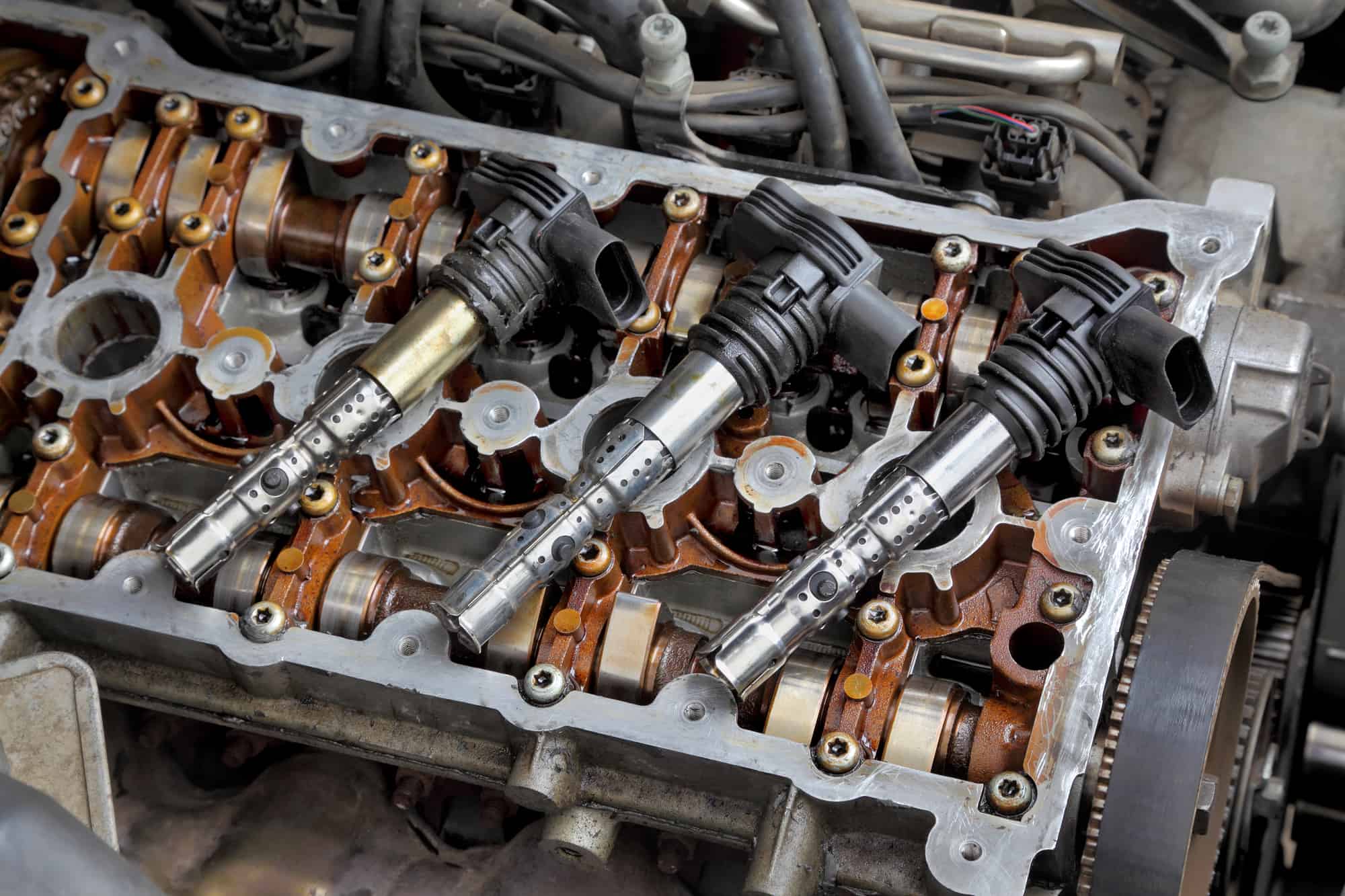There are many possible symptoms of a bad ignition coil. A bad ignition coil can cause engine misfires, a rough engine idle, a decrease in power, poor fuel economy and an engine that is difficult to start.
In most cases, if even one ignition coil has failed you should not drive the vehicle as you run the risk of damaging the engine and causing catalytic converter failure.
It’s fairly easy to diagnose a bad ignition coil with a diagnostic code reader. The engine error code for a problem with one or more ignition coils is P0351.
Bad Ignition Coils (6 Of The Most Common Symptoms Explained)
Properly functioning ignition coils are vital for an engine to run properly. If one or more of them fail, then the car is going to run really badly and will probably stall if you push it beyond a few miles per hour.
The ECU controls the power to the ignition coils. It decides the frequency and timing of the firing of the spark plugs. If one of the ignition coils is bad, this will knock out the engine timing and will severely impact how the engine runs.
It is possible for an ignition coil to fail intermittently. They can also become damaged due to excessive heat and vibration. This can damage the internal windings of the coil causing shorts. Ignition coils can also be damaged through voltage overload caused by bad spark plugs. This will lead to intermittent misfires, and will lead to poor fuel economy.
Symptom 1. Check Engine Light Stays on
The most common sign of a bad ignition coil is a check engine light on the dashboard. Ignition coils are electronically controlled by the ECU and will trigger an engine error code if they fail.
A bad ignition coil will also cause problems with the engine combustion cycle, resulting in engine performance issues and misfires. This will also cause the check engine light to come on, even if the faulty ignition coil is somehow not picked up by the ECU.
If the check engine light is on, it’s always wise to run an engine diagnostic to narrow down the source of the problem. A common engine code for a faulty ignition coil is ‘P0351 – Ignition Coil ‘A’ Primary/Secondary Circuit Malfunction’. You will almost always see engine error codes related to engine misfires and these can include P0301 to P0306 (depending on the number of coils fitted to the engine).
Symptom 2. Poor fuel economy
Another very common symptom of a faulty ignition coil (especially if it hasn’t failed completely) is a reduction in fuel economy.
If an ignition coil is not providing enough power to the spark plug and at exactly the right time, the fuel combustion process will not be efficient and a noticeable decrease in fuel economy will be evident. This will usually show up as an engine misfire and it may also cause the check engine light to come on.
If fuel is not burning completely in the combustion chamber because of a problem with ignition, this can damage the engine over time. It will usually affect the spark plugs first, causing a build up of carbonised fuel around the spark plug tip. It can also cause damage to the valve and piston faces, with scorching and hot spots occurring due to localised high temperatures where the excess fuel burns.
Symptom 3. Rough Engine idle and Difficulty starting the engine
Other engine performance problems such as a rough idle or an engine that won’t start can also be signs of a faulty ignition coil.
For an engine to start, especially when cold, all of its cylinders must be capable of firing so as to create the internal pressure needed to keep the engine turning after the starter motor has stopped. A bad ignition coil is going to reduce the burning of fuel in the affected engine cylinder, and this will often result in an engine not starting.
If the engine is starting but sounds rough or is misfiring when idling, this can also be a sign of a bad ignition coil. Just like when driving at speed, when the engine is idling it need to burn a precise amount of fuel at exactly the right time. A bad ignition coil can adversely affect the ignition timing and this can cause the idle speed to fluctuate outside of its normal range.
Symptom 4. Intermittent and Recurring engine misfires
A faulty ignition coil will almost always cause engine misfires. It can sometime be difficult to pinpoint the exact cause of these engine misfires if they are intermittent and if the bad ignition coil does not always trigger an engine error code.
Sometimes the ignition coil can start to fail due to damage to the primary or secondary winding within the ignition coil. As a result it may not be able to generate sufficient voltage to power the spark plug consistently. This reduction in power will affect the efficiency of the combustion process, and will cause engine misfires that will affect overall performance.
As usual, the best way to diagnose engine misfire problems is by starting with an OBD-II engine diagnostic readout. You may also need to swap out the suspected ignition coil and also check the condition of the spark plugs to confirm diagnosis, especially if the problem is intermittent or if the error codes don’t point directly to a specific ignition coil.
Symptom 5. Engine hesitation during acceleration
Another common sign of a faulty ignition coil is a reduction in engine performance, especially when the engine is under heavy load while accelerating.
Any problems with the ignition coils are going to affect the combustion cycle, especially the timing of the combustion, and this will lead to a drop in power output from the affected cylinder.
Symptom 6. Exhaust Back-fire
Finally an often overlooked sign of a bad ignition coil is an audible back fire from the exhaust. If the spark plugs aren’t sparking properly, fuel particles won’t burn in the combustion chamber as they usually do. These can then enter the exhaust pipe with a high energy charge.
That energy will be unleashed in the form of mini explosions. It’s important to find and fix the source of engine misfires as it is possible for the catalytic converter to become damaged by the unburnt fuel in the exhaust emissions.
What Next: How To Test For A Bad Ignition Coil
The ignition coil transforms the battery voltage (12V) into the thousands of volts necessary to initiate the ignition on the spark plug. It provides the energy required by spark plugs to create the spark for combustion to occur.

A common symptom of a weak ignition coil is a “no spark” condition. But how can you tell if an ignition coil is weak? The most reliable method is to check for a spark is with a spark tester. A spark tester looks like a spark plug but has a recessed center electrode that simulates a load on the ignition coil.
Several factors determine the amount of energy required to create the electric arc in the spark plug. Some of them are the engine compression, air-fuel ratio, combustion chamber temperature, spark plug materials, spark plug calibration (aperture), etc.
Over the years, vehicle manufacturers have focused on developing more efficient engines. That implies engines with higher levels of compression and leaner fuel delivery. These changes demanded more and more energy from the ignition system. As a consequence, single coil engines became obsolete opening the way to multi-coil systems.
Nowadays, the most common multi-coil system is known as Coil-On-Plug (COP). This particular design consists of one ignition coil per cylinder. Each coil is directly attached to the spark plug, which contributes eliminating electrical loses from spark plug wires. Unless stated otherwise, this article will assume that your vehicle is using a COP system.
Basically, an ignition coil is a small transformer. As with any transformer, it has a primary winding and a secondary winding. It receives battery voltage on the primary winding and when the current is disrupted the magnetic field collapses causing a huge voltage output on the secondary winding.
Modern ignition coils have output voltages in excess of 45,000 volts. This is often necessary to ignite the ultra-lean mixture of fuel injection systems.
Unlike traditional single-coil ignition systems, on current COP systems, the Electronic Control Unit is in charge of activating each individual coil when it’s needed.
Most COP electrical connectors consist of three wires: one for ground, one for battery voltage and one for ECU activating signal. It’s not uncommon that all three wires connect directly with the ECU because many designs incorporate current and/or ground monitoring for each coil.
In this section I’ll outline how to tell if the ignition coil is bad. Depending on your vehicle, you may need one or more of the following tools:
- OBD2 Code Reader
- Digital multimeter (DMM)
- Automotive diagnostic scanner with live data capabilities
- Inductive type ignition analyzer (inductive pickup tool).
Always refer to the appropriate OEM literature when possible. Original manufacturer diagnostic procedures should always have precedence over a generic workflow.
1. Preliminary steps
Recommended tools: OBD2 Code Reader / automotive scan tool
> Data trouble codes: using an OBD2 code reader take note of any DTC present in the ECU memory. For doing so you only need to connect your code reader and turn the ignition key on (engine off), a state usually known as KOEO.
> Data trouble codes clear: now that you know what codes were stored into memory you need to clear them. This is usually done selecting “clear codes” in your tool.
> Driving cycle: disconnect your OBD2 code reader and start the engine, this state is commonly known as KOER (Key On Engine Running). If the Check Engine Light turns on then stop the engine and continue with the diagnostic. If the Check Engine Light remains off then drive the vehicle for 5 to 10 minutes. If the light remains off you may have an intermittent problem. If the light lit during your driving cycle then continue with the diagnostic process.
2. Visual Inspection
Recommended tools: none
> Coil wiring: perform a meticulous visual inspection of each coil wiring. Look for burnt, damaged, corroded or deteriorated wires. Pay special attention to possible shorts to ground or open circuits produced by a faulty insulation.
> Coil harness and connector: similar than before, perform an exhaustive visual inspection of each coil connector. Ensure that the ignition key is switched off and unplug each coil harness connector. Look for bent terminal pins, loosely connections, corrosion or any other possible indication of a bad connection.
> Coil condition: in order to check the coil condition you’ll need to remove each coil from the engine. Refer to the last section if you have any doubt about the procedure. Perform a meticulous visual inspection of each coil. Look for burnt, damaged, cracked, corroded or deteriorated coil boot, spark wire or coil housing. Pay special attention to any sign of water, oil or moisture. Any liquid in contact with the coil will damage it very quickly. Repair as necessary.
Fix any wiring problem before continuing.
3. Electrical Tests
Recommended tools: digital multimeter (DMM)
> Supply voltage: refer to the proper wiring diagram and identify the terminal corresponding to the +12V line. In order to measure the supply voltage, you will need to enter in KOEO mode (Key On Engine Off) and turn the digital multimeter dial to “voltage” test mode.
Now place one multimeter probe in a known ground (battery negative is a good one) and the other probe tip in the terminal of the coil wiring harness corresponding to the +12V supply. If the measured value is below 95% of the battery voltage then you will need to check the entire line from the coil harness all the way to the ECU itself.
> Ground test: enter in KOEO mode (Key On Engine Off) turn the digital multimeter dial to “voltage” test mode and place one probe tip on the coil harness terminal corresponding to the supply voltage and the other on the terminal that should be the ground.
Ideally, the voltage would be the same value as the previous test, if the difference is greater than 10%, then you will need to check electrical resistance and continuity of the ground line from the coil harness all the way down to the ECU.
4. Scan Tool Tests
Recommended tools: automotive scan tool with live data capabilities.
> Cylinder Misfire live test: using an automotive diagnostic scanner you can indirectly diagnose faulty coils. Enter in live data mode and look for cylinder misfire values. Most modern engines discriminate the misfires for each cylinder. Ideally, no cylinder should report misfire problems. If a particular cylinder has a high misfire count you can suspect from fuel injection, spark plug or ignition coil as the most probable causes.
> Coil On Plug functional test: some manufacturers include special tests or functional tests for the ignition coils. Follow on-screen instructions to complete those tests.
5. Ignition Coil Direct Tests
Recommended tools: Inductive type ignition analyzer.
> Coil live test: using an Inductive type ignition analyzer you can test the coil activation in real time. Depending on the model of your tester you may check ignition coil activation, spark plug duration time, coil output voltage, and even graphing the ignition coil pattern. The great advantage of this tool is that you only need to “touch” the coil that you want to test. It uses inductive technology (the same electrical principle that drives the ignition coil) so is the most practical way to test COP systems quickly and accurately.
How To Replace A Bad Ignition Coil
Coils part of COP systems are usually located above each spark plug on the valve cover.
Recommended tools: OBD2 Code Reader, safety glasses, mechanics gloves, appropriate screwdrivers, torque wrench, proper illumination (LED flashlight),
- > Preliminary steps: ensure that the ignition switch is off and then disconnect the vehicle battery. Detaching the negative terminal is usually enough.
- > Remove coil connector: this step may be tricky in some models. Generally speaking, the connector has a plastic tab that you should push down while you pull out the harness. But in many cases, there is a small security clip (sometimes plastic, sometimes metallic) that must be removed first using an adequate screwdriver.
- > Remove coil: most COP systems use a plastic cover to protect the coils. Lift the cover and use the appropriate tool to remove the coil. You will find it an easy task since usually, coils are attached with two bolts.
- > Install the new coil: retire the old coil and then install the new one. Double check that you’re using the adequate part number.
- > Reconnect the coil and battery: once you are done, reconnect the coil (don’t forget security clips) and then the battery terminal.
- > Clear DTC memory: using the OBD2 code reader clear the ECU memory to prevent any false code been stored. You will need entering in KOEO mode for doing so.
- > Perform driving cycle: once you are done, drive the vehicle for more than 10 minutes. Try to accelerate as you would normally do.
FAQ: Symptoms of a bad ignition coil
1. What does a bad ignition coil sound like?
A bad ignition coil will usually have similar symptoms to a bad spark plug. Trying to start and engine will one or more faulty ignition coils will be difficult and the engine will likely splutter, hesitate, misfire and stall. A bad ignition coil doesn’t make a noise itself, but will sound like an engine that is struggling to run properly.
2. What does a bad ignition coil look like?
A bad ignition coil can, and usually does look like a working ignition coil. Usually when a coil fails, it’s because one of the components (the transformer or wiring) inside the coil is damaged.
Some failed coils can look burnt, with a cracked or corroded housing. Some can also have a worn or deteriorated coil boot or coil housing. If the outer housing becomes cracked this can lead to water or moisture getting into the coil and damaging it.
As an Amazon Associate we earn from qualifying purchases.









Could a fluctuating idle speed while in traffic indicate an issue with the ignition coil?
I’ve been noticing that my car struggles to accelerate and sometimes stalls, especially under heavy load. Could these issues be related to a faulty ignition coil, and how can I confirm this before taking it to a mechanic?